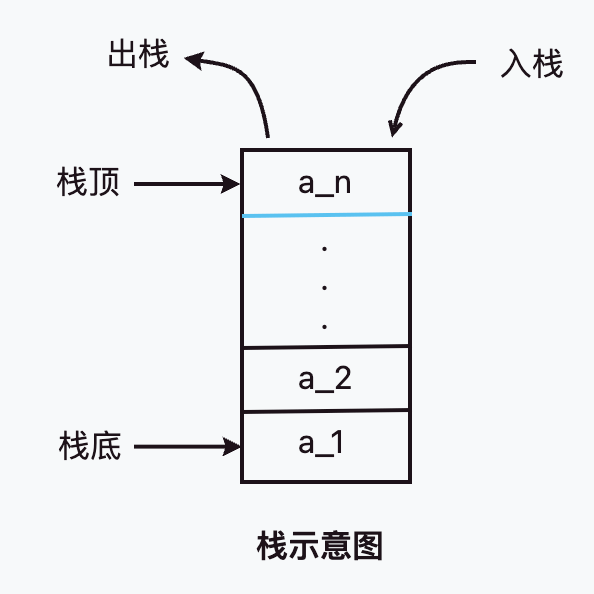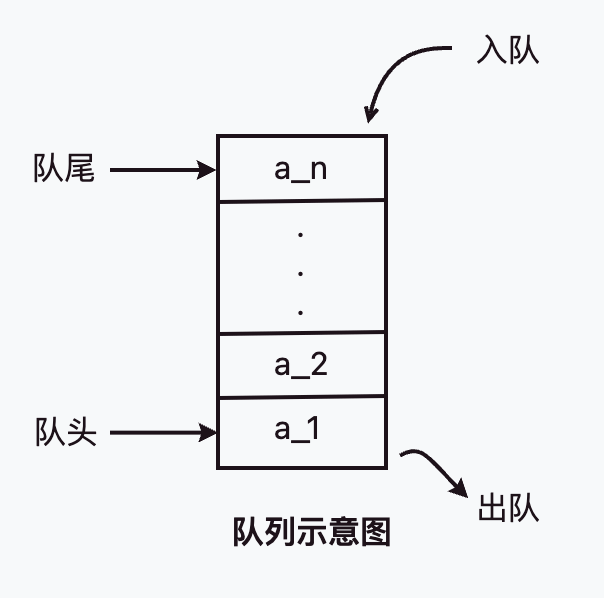栈和队列
栈
栈是限定在表的一端进行插入和删除运算的线性表,插入、删除的一端称为栈顶,另一端称为栈底。如果一个栈不含任何元素则称为空栈。 栈又称为后进先出线性表,简称为LIFO表。
比如装箱子,都是从底部开始一层一层往上放(入栈);假如这时要拿底部那层的物品,是不是就需要从顶层开始一层一层拿出来(出栈)。

当栈满时,再进行入栈操作会产生“上溢”;当栈空时再进行出栈操作会产生“下溢”。
栈的基本运算有:
- 置空栈
- 判断栈空
- 判断栈满
- 入栈
- 出栈
- 取栈顶元素
📝 现在就在下面简单实现一下这些运算~
栈的定义
💡 JavaScript 中实现栈就非常简单了,通常使用数组模拟实现。
#define StackSize 100
typedef char DataType; // DataType 类型根据实际情况定,这里是 char
typedef struct {
DataType data[StackSize];
int top;
} SeqStack;
SeqStack s;type SeqStack = string[]
const StackSize = 100 // 栈的长度,后面用到
const seqStack: SeqStack = [] // 注意 js 中数组长度是可变的,因此需要在入栈限制,后续讲到
// int top = seqStack.length - 1 // 因为数组长度就是栈顶的索引,因此没必要保存
// 还有一种方法,但不推荐
const seqStack: SeqStack = new Array(StackSize)
int top = -1 // 此时就需要记录栈顶索引了,数组长度不再表示栈顶索引。
// 注意:同时下面的出入栈也不能这么写了。置空栈
void InitStack(SeqStack *S)
{
// 原因数组的下标从0开始,因此不能使用0
S->top = -1;
}function initStack(s: SeqStack) {
// 因为 JS 中数组在函数参数中传递的是引用,因此会修改到原数组变量
s = []
}判断栈空
int StackEmpty(SeqStack *S)
{
return S->top == -1;
}function stackEmpty(s: SeqStack) {
return !!s.length
}判断栈满
int StackFull(SeqStack *S)
{
return S->top = StackSize - 1;
}function stackFull(s: SeqStack) {
return s.length === StackSize
}入栈
JavaScript 中的出入栈就非常简单了,就是数组的 push、pop 方法。
void Push(SeqStack *S, DataType x)
{
if (StackFull(S))
{
prinf('stack overflow');
}
else
{
S->top = S->top + 1;
S->data[S->Top] = x;
}
}function push(s: SeqStack, x: string) {
if(stackFull(s)) {
console.error('stack overflow')
} else {
s.push(x)
}
}出栈
DataType Pop(SeqStack *S)
{
if (StackEmpty(S))
{
prinf('stack underflow');
exit(0);
}
else
{
return S->data[S->top--];
}
}function pop(s: SeqStack) {
if (stackEmpty(s)) {
throw new Error('stack underflow')
} else {
return s.pop()
}
}function push(s: SeqStack, x: string) {
if (stackFull(s)) {
console.error('stack overflow')
} else {
s.push(x)
}
}取栈顶元素
DataType GetTop(SeqStack *S)
{
if (StackEmpty(S))
{
prinf('stack underflow');
exit(0);
}
else
{
return S->data[S->top];
}
}function getTop(s: SeqStack) {
if (stackEmpty(s)) {
throw new Error('stack underflow')
} else {
return s[s.length - 1]
}
}❗ 因为在某一些语言中,在声明数组时就需要确定分配的空间,为了克服固定空间所产生的溢出问题和空间浪费问题,还有一种栈的实现方式,使用链式存储结构来存储栈,称为链栈。 因为 JavaScript 中数组是可动态改变的,因此在大多数情况下都是使用它来实现,所以这里就不解释链栈了。 链式存储结构知识可以查看 👉🏻 《线性表》
应用场景(列举部分)
- 括号匹配。
- 回文数(比如 LeeCode 第9题)。
- 递归实现原理。
队列
队列也是一种线性表,它只允许在表的一端进行元素插入,在另一端进行元素删除。允许插入(入队)的一端称为队尾,允许删除(出队)的一端称为队头。 队列称为先进先出表,简称FIFO表。
*比如排队上公交,排在最前的一端先上公交,后到的人只能到队尾进行排队等候。温馨提示文明出行,禁止插队。*🚌 🚌 🚌

队列的基本运算有:
- 置空队列
- 判断队列空
- 判断队列满
- 入队
- 出队
- 取队头
队列定义
💡 C语言的看过来: 因为队列也是会存在上溢问题,如果将队列的存储空间定义得太大,则会产生空间浪费,因此可将数组空间想象为一个环形空间,称这种表示的队列为循环队列。 通过少用一个元素空间,在入队前,先判断尾指针在循环下加1后是否等于头指针,若相等则认为队列满。 下面C语言的实现也是主要介绍这种!
#define QueueSize 100
typedef struct
{
DataType data[QueueSize];
int front, rear;
} CirQueue;
CirQueue Q;type SeqQueue = string[]
const QueueSize = 100
const seqQueue: SeqQueue = []置空队列
void InitQueue(CirQueue *Q)
{
Q->front = Q->rear = 0;
}function InitQueue(q: SeqQueue) {
q = []
}判断队列空
int QueueEmpty(CirQueue *Q)
{
return Q->rear == Q->front;
}function QueueEmpty(q: SeqQueue) {
return !q.length
}判断队列满
int QueueFull(CirQueue *Q)
{
return (Q->rear + 1) % QueueSize == Q->front;
}function QueueFull(q: SeqQueue) {
return q.length === QueueSize
}入队
void EnQueue(CirQueue *Q, DataType x)
{
if (QueueFull(Q))
{
printf("Queue overflow");
}
else
{
Q->data[Q->rear] = x;
Q->rear = (Q->rear + 1) % QueueSize;
}
}function EnQueue(q: SeqQueue, x: string) {
if(QueueFull(q)) {
throw new Error('Queue overflow')
} else {
q.push(x)
}
}出队
DataType DeQueue(CirQueue *Q)
{
DataType x;
if (QueueEmpty(Q))
{
printf("Queue empty");
exit(0);
}
else
{
x = Q->data[Q->front];
Q->front = (Q->front + 1) % QueueSize;
return x;
}
}function DeQueue(q: SeqQueue) {
if(QueueEmpty(q)) {
throw new Error('Queue empty')
} else {
return q.shift()
}
}取队头
DataType GetFront(CirQueue *Q)
{
if (QueueEmpty(Q))
{
printf("Queue empty");
exit(0);
}
else
{
return Q->data[Q->front];
}
}function GetFront(q: SeqQueue) {
if(QueueEmpty(q)) {
throw new Error('Queue empty')
} else {
return q[0]
}
}❗ 队列中除了比作循环队列,还有一种链式存储结构的队列,称为链队列,也能解决空间浪费问题,这里也不详细解析了,有兴趣可以自己实现一遍。
应用场景(列举部分)
- 购票系统
- 滑动窗口
- 消息队列